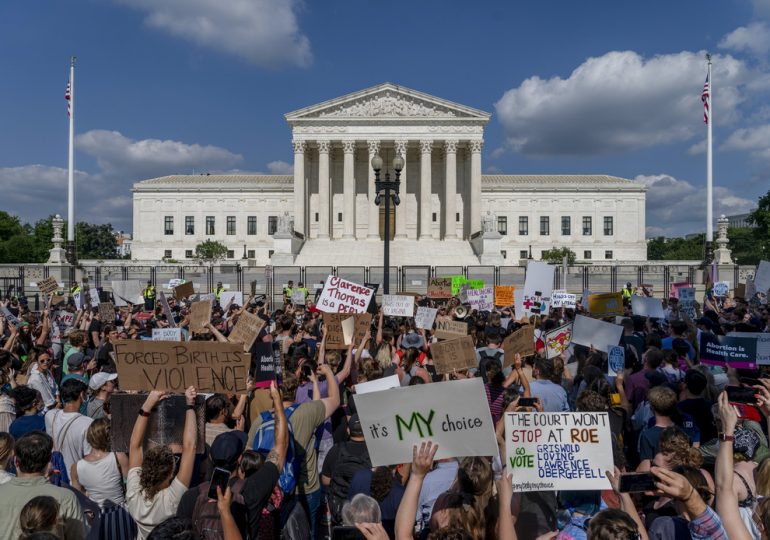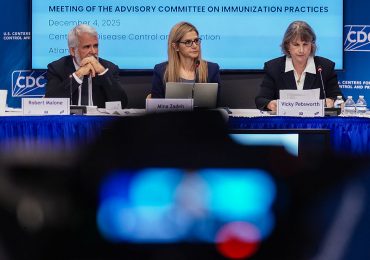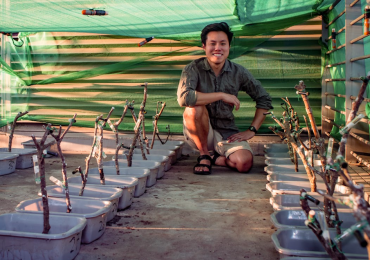In the months after Texas banned abortion in nearly all situations, Dr. Lou Rubino stayed and continued treating patients in Austin.
“I just had in mind I could still do something—I would be able to do some good, help some people,” says Rubino, who had lived and worked in the state for years.
[time-brightcove not-tgx=”true”]
But one day, Rubino was treating a patient. She was 16. Pregnant. And she was telling Rubino that she needed an abortion.
“I knew that she really needed that abortion, just like all my patients need their abortions,” Rubino says. “I knew inside of my soul, in some very deep place, this is wrong. For me to not do her abortion, for me to refer her out of state, for me to tell a pregnant person to get in their car and drive hours—putting them at risk for blood clot—to go get their health care somewhere else—that I should be able to do—is morally wrong.”
“Coming to that impasse was when I said: that’s it,” Rubino says. They realized that “to do the kind of care that I do, I needed to leave.” So they did.
Rubino is not alone. In the three years since the Supreme Court ruled in Dobbs v. Jackson Women’s Health Organization, overturning the landmark Roe v. Wade decision that protected the right to an abortion, many doctors have decided to leave states they had been practicing in for years, after lawmakers enacted restrictions, and move to states where abortion is legal.
Texas is one of 12 states currently enforcing near-total bans. Four states have banned abortion after six weeks of pregnancy—before many people even know they’re pregnant.
A survey released earlier this month found that, in the year after the Dobbs decision, 42% of clinicians who provided abortions in states that had near-total or six-week bans relocated to another state—nearly all of them to states that hadn’t imposed a ban. In comparison, just 9% of clinicians who practiced in a state that didn’t impose a ban relocated to another state.
About one in five ob-gyns practicing in Texas have considered leaving the state to practice elsewhere, a survey released in October found. Idaho, which has a near-total abortion ban, lost about 22% of its practicing obstetricians in the 15 months after its restrictions went into effect, according to a report released last year.
Doctors across the country who spoke with TIME in the lead-up to the third anniversary of the court’s ruling recount the moral distress they have felt when patients come in seeking care that they are no longer legally allowed to provide under their states’ laws. In the rare circumstances in which they are permitted to provide that care, they say they have to jump through more hoops than they did before Dobbs. And they describe fear: doctors, nurses, and pharmacists fearing they will be arrested, jailed, fined, or lose their licenses for providing care, and patients fearing getting in trouble and hesitating to share everything with doctors.
Even before the decision, the U.S. had one of the highest maternal mortality rates among developed nations. And experts worry that restricting abortion will cause those numbers to worsen. Many pregnant people have said that they were denied appropriate care at hospitals in states that have banned abortion, even though they were experiencing serious complications. Investigations have found that pregnancy became more dangerous in Texas after the state restricted abortion access. Research has also found that infant mortality was higher than expected in the majority of states that had abortion bans in the year after the Dobbs ruling. Earlier this month, the Trump Administration rescinded Biden-era guidance that had instructed hospitals to provide emergency abortions, even in states where abortion is restricted—a move that doesn’t change federal law, but that doctors and abortion-rights advocates fear will only exacerbate the confusion over when doctors can provide care in emergency situations.
Dana Howard, an assistant professor in the division of bioethics at Ohio State University who conducted the survey of clinicians released earlier this month, says that she and her colleagues found that nearly all of the clinicians they surveyed weren’t only providing abortion care.
“When abortion providers end up moving, that doesn’t mean that it’s only the abortion provision that ends up being relocated—their whole primary practice is being relocated, and that means that patients end up being left behind, without access to the full spectrum of reproductive health care,” Howard says.
New barriers to care
In May 2023, Rubino, a fellow with Physicians for Reproductive Health, moved to Virginia, where abortion is generally legal until around fetal viability. They worked at a clinic there for a few months before opening a clinic with some colleagues in the northern part of the state, near Washington, D.C. Leaving Texas and being able to provide the care they had trained for, Rubino says, was a relief.
Dr. Kristl Tomlin, a pediatric and adolescent gynecologist, also moved to Virginia, leaving South Carolina last year after encountering new hurdles in her efforts to provide care.
Tomlin was working in South Carolina in the winter of 2023 when she treated a patient who had an abscess on her ovaries. After running some tests, Tomlin found out that the patient was pregnant. The patient was well into her 40s, had six kids, and was very sick. When she learned she was pregnant, she started to sob, and asked for an abortion. South Carolina bans abortion after six weeks of pregnancy. But because the patient was only four weeks and six days pregnant, she could still get an abortion under the state’s law.
“We can do this,” Tomlin, who is a fellow with the American College of Obstetricians and Gynecologists, recalls thinking. “We are well within six weeks. Only by the grace of God are you here—this would have never happened otherwise.”
But before she was permitted to provide an abortion, Tomlin had to call the medical institution’s lawyer multiple times. The patient had to get two transvaginal ultrasounds. Then Tomlin had to argue with the pharmacy to get the patient the medication. By the time the medication arrived, it was after Tomlin’s shift had ended, and the provider who took over refused to do the abortion. A resident physician volunteered to do it instead.
Tomlin’s colleague gave the patient the medication, which had to be placed intravaginally. But the medication fell out. The patient, too afraid to tell the doctor about it after going through that whole process, remained pregnant, and went on to have the baby.
“It was just ridiculous,” Tomlin says of the hoops she had to jump through. “Something that should be so simple occupied hours and hours of phone calls and fighting and lawyers.”
The stress of navigating the state’s six-week ban took a toll on Tomlin; she couldn’t sleep, and she suddenly had trouble eating gluten without getting sick. Once, she heard a car alarm go off in the middle of the night. When her husband, half asleep, told her to call the police, she burst into tears.
“I can’t call the police,” she recalls thinking. Under South Carolina law, Tomlin was required to contact law enforcement if she was performing an abortion that fell within the state’s exceptions for rape and incest. She had interacted with the police before, and was terrified that she would be a target for the authorities because of her work. “What a horrible thing, to be scared to call the police about a car alarm because you’re not sure what the police are going to do when they see your name,” Tomlin says. “I have never done anything wrong. But I was too scared to call the police. And that’s not a way to live.”
“It became abundantly clear that I was not going to be allowed to practice true medicine that truly cared for my patients in the way they needed me to be there for them without personal fear for my safety and for that of my family,” Tomlin continues. “And that’s not sustainable; I can’t live a career like that.”
Soon after, Tomlin received a job offer in Virginia. At first, she wasn’t sure what to do. Tomlin had been in South Carolina since 2017, and she, her husband, and their kids loved their life there. But Tomlin and her husband felt that the move was necessary for her well-being.
Tomlin and her family moved to Virginia last August. Almost immediately, Tomlin began feeling better—she can eat gluten again, and she loves her new job. But the move “still feels so very raw,” she says.
“I wanted to stay [in South Carolina] and I wanted to take care of those patients—and I am not,” Tomlin says. “They lost someone who was willing to be there and happy to be there.”
The guilt of leaving
In South Carolina, 13% of the state’s counties are classified as maternity care deserts, and 15 counties have no ob-gyns per 10,000 women. Experts worry this issue will only get worse in the post-Dobbs landscape.
“There is an exodus of ob-gyns leaving South Carolina, which we all said would happen,” Tomlin says.
There were already health care deserts and barriers to accessing reproductive health care before the Dobbs ruling, says Howard, the Ohio State University professor, and the decision appears to be exacerbating those disparities.
Several doctors who spoke with TIME say that leaving the states they had practiced in for years sparked feelings of guilt, and they often think of their patients who are still there.
Dr. Leilah Zahedi-Spung, a maternal fetal medicine and complex family planning provider, had not planned on leaving Tennessee. But after the Supreme Court’s decision, the state enacted a near-total abortion ban. A few months later, Zahedi-Spung received a job offer in Colorado, where abortion is allowed at any stage of pregnancy. Facing mounting stress and frustrations working under one of the country’s strictest abortion restrictions, Zahedi-Spung decided to leave the state that had been her home for almost two years.
She says it was the right decision for her and her family. She had spent most of her medical career working in states where abortion access is a challenge, but now, she says, working in Colorado “is the most genuine form of medicine that I’ve been able to practice.”
“The best part about being in Colorado is that no one enters my exam room with me other than me—there’s no legislator, there’s no politician, there’s no hospital lawyer,” says Zahedi-Spung, who is an advocate for the reproductive rights advocacy nonprofit Free & Just. “I do a lot more good here than I could have done in Tennessee.”
She still treats some patients from her old practice who travel to see her. Many of the patients she and her colleagues in Colorado see are coming from out of state: The volume of patients her office sees increased significantly in the year after the Dobbs ruling, and the average distance patients travel to see her and her colleagues jumped from 25 to 250 miles one way.
But Zahedi-Spung thinks of her old home often.
“I think I’ll probably carry the guilt of leaving with me for the rest of my life,” she says. “Why wasn’t I strong enough?”
Those are feelings that Dr. Stacy De-Lin is familiar with.
De-Lin, now the associate medical director at Planned Parenthood Hudson Peconic in New York, had been practicing in the state for years by 2020. But she grew up in Florida, and when she heard Planned Parenthood of Southwest and Central Florida needed a provider that year, she moved there to be the chief medical officer, working in a rural area near Fort Myers. She was there when the Dobbs ruling came down, and when Florida banned abortion after 15 weeks of pregnancy soon afterward. De-Lin, a fellow with Physicians for Reproductive Health, saw some patients who, at 20 weeks of pregnancy, learned that their fetuses had severe anomalies and were unlikely to survive. But many of them were still forced to carry their pregnancies to term because they didn’t fall under the limited exceptions permitted under Florida’s law.
“The patients were so devastated. They were so hopeful for this pregnancy, were already suffering so much, and then I couldn’t help them,” De-Lin says. “It was so horrible to have my hands tied and not be able to help these patients.”
While some of her patients were able to travel out of state to access abortion care, many of them couldn’t afford it. De-Lin worried that if one of her patients were to develop pregnancy complications, like sepsis, she wouldn’t know what care she would be allowed to provide under the state’s law.
“I’ve just never operated in a setting like that,” De-Lin says. “In medical training, you’re trained to just make decisions based on the evidence and the patient’s preference. It was just such a bizarre thing to have these poorly written laws shoved into the exam room.”
When it became clear that Florida would further restrict abortion care with a six-week ban, De-Lin decided it was time for her to go back to New York, where abortion is permitted until around fetal viability, with some exceptions after that.
The move, though, sparked a lot of conflicted feelings in her. She felt like she was leaving her patients in Florida behind. But she knew that many patients were going to travel out of state to get care, and thought she would be able to better serve patients in a state where abortion was legal.
“The laws have made it so restrictive that it just doesn’t feel safe to practice medicine there,” she says. “I didn’t train to become a doctor to tell people I’m not able to help you.”
‘It’s very hard’
The Dobbs ruling prompted Dr. Danielle Gershon to move as well—from New York to Alabama, which has a near-total abortion ban.
“I have family in the South, and it had always been in my plan to eventually move South, but once Dobbs happened, I immediately felt this need to do something about it as an abortion provider,” Gershon says. “I started to think, if I stay in New York, abortion is already very accessible in New York; I’m one of many abortion providers. If I move to the South, perhaps my presence there could make this care that is now even more restricted a little bit accessible for someone.”
Alabama allows abortion only in very limited circumstances, such as if it’s necessary to save the pregnant person’s life. The state’s ban has no exceptions for rape or incest. Gershon, an ob-gyn and complex family planning provider, performs abortions in the instances when it is permitted in the state.
“It’s very hard,” she says. “And sometimes I just wish that I was living in a state where I could provide abortion care the way that I was providing abortion care when I lived in New York. But then I help a patient get the care that is legal and that they decided they wanted for themselves and nothing feels better than helping a patient exercise their own bodily autonomy.”
“That makes it worth it,” she says.
There are times when she and her colleagues are not able to provide abortions because patients’ circumstances don’t fall into the law’s narrow exceptions.
In those cases, “there’s not a lot that I can do to help them get that care,” says Gershon, who is also a fellow with Physicians for Reproductive Health. “It’s frustrating every single time it happens because I can remember a time when I would’ve been able to give them that care. And now I can’t.”
Many doctors have expressed anger and frustration at the lawmakers behind the abortion bans and restrictions. Reflecting on the anniversary of the Dobbs decision, doctors tell TIME that they wish more people understood that these restrictions affect everyone. They say these laws don’t respect or protect patients, and that medical decisions should be left up to patients and their health care professionals.
“I’m an expert in this; I know what I’m doing, I know what my patients need,” Gershon says. “Lawmakers are not experts in this. So why is it that they are allowed to make these choices?”
Leave a comment





